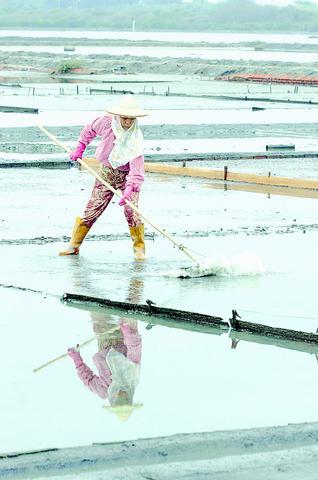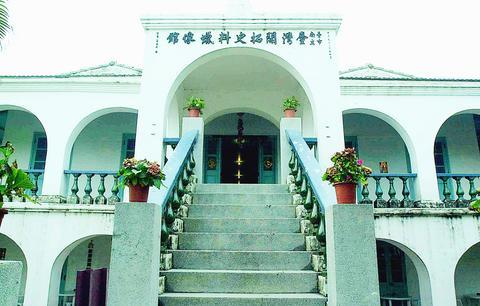The vast fields and adjoining buildings were once the center of one of Taiwan's most important industries -- making salt. With the decline of the industry they were left derelict, subject to the ravages of time and weather.
But now, with support from the Tainan City Government and the national Council for Cultural Affairs the plantation will be restored as the Salt Field Ecology and Cultural Village as part of a plan to revitalizing both the industry and the city.

PHOTO: CHIANG YING-YING, TAIPEI TIMES
The salt fields in Tainan span the old port areas between An-nan (

PHOTO: CHIANG YING-YING, TAIPEI TIMES
The salt-field operations started in 1919 during the Japanese occupation of Taiwan. At the time, the salt production was monopolized. But as the modern electrolysis salt-making technology replaced the traditional salt works, the operation was halted in 1994 and the vast fields with their production facilities were abandoned.
The Salt Field Ecology and Cultural Village plans to use these assets to turn itself into a tourism spot by exhibiting the cultural, historical, industrial and natural resources of the area.
Chairwoman of the Council for Cultural Affairs Tchen Yu-chiou (
"Every concept of these policies is realized in Tainan's Salt-Field Ecology and Cultural Village," Tchen said.
The village, defined as a local culture center, gets its funding from the council's budget for repairs of buildings at county and municipal culture centers.
Tchen also lauded the abundant natural resources surrounding the salt-fields, the 500-hectare Szu-tsao Wildlife Protection Zone (
Tainan City Mayor Hsu Tien-tsai (
Among the various resources to be restored, the salt-making equipment and installations are considered the priorities.
These facilities include the waterway transportation facilities such as the canal, port, dock and raft, as well as the machinery at the water-pumping station.
Living museum
The old warehouse at the dock is to be renovated into a museum to display the salt-making tools and other machinery which depicts the heyday of the salt-field operation.
The square-shaped salt pans, which are hung on racks to employ wind evaporation, will also be put back into operation.
Those running the center believe that keeping the facilities in use is the best way to maintain the wood and clay-brick buildings which would fall apart without proper care.
However, not every inch of the salt fields will be put back into operation, since it would not be economical to employ the labor-intensive practices that would be necessary for the the mass production of salt in this way
But the resumption of work on a limited scale is aimed at sustaining and maintaining the culture, history and traditions of the industry and educating people about them.
In addition to the 50-hectare salt plantation, the village includes a 16-hectare bird habitat area.
Tainan City Deputy Mayor Hsu Yang-ming (
Hsu said the salt itself will be a key attractions for tourists who come to learn the process of making salt.
"We will make it a three to four-day package tour for tourists who can come to stay in the village during the weekends to learn about salt-making, and at the same time watch the numerous birds that inhabit the the salt marshes," Hsu said.
On the site visitors will use the traditional tools such as water wheels, windmills, rakes, bamboo baskets and cross-shoulder carrying poles.
In addition to experiencing the salters' life, other features of the village also include the making of handicrafts such as bamboo nests, silk scarves, and woodblock printing mastered by the salt-field villagers who utilize the existing materials to make the handicrafts.
An important part of the history of the salt-fields operation are the generations of salt workers who lived and worked there.
But nine years ago when the salt-operation was called off, the villagers started to switch to other vocations and other locations.
Roots
The salt-field terrain is 30cm below sea level -- which led to constant flooding of their traditional dwellings in the middle of the salt fields. At the end of last year, all of the villagers who used to live in the central island of the salt-fields were evacuated to the neighboring community.
Nevertheless, the villagers finally went back to their roots in the salt fields when they were informed that the government was to revitalize the operations.
"These villagers are very spontaneous and zealous about being able to come back to their family land to carry out their ancestors' business," Hsu said.
"The speed with which they demolished their old buildings surprised us. They are very efficient in doing what we told them to do, as they have a special connection with this land that makes them so devoted," Hsu said.
The repair work for the construction of the Salt Field Ecology and Cultural Village will require a NT$12 million budget.
"The villagers started the preparation work long before the budget arrived. They just can't wait to see their homeland begin to prosper again," Hsu said.
In addition, several bird watching pavilions have been built with the driftwood found on the beach.
"They use the materials on the beach for building. In that way, they also help keep the beach clean," Hsu said.
Currently, the salt-fields are in the care of both the city government and private organizations which involve historical scholars and environmentalists to preserve the cultural and natural assets.
The construction of the village is scheduled to be completed by the end of next year. During the salt-making season, which spans from October to April, the village is to be open fully. During the off-season, visitors must make an appointment if they wish to tour the facilities.

SHIPS, TRAINS AND AUTOMOBILES: The ministry has announced changes to varied transportation industries taking effect soon, with a number of effects for passengers Beginning next month, the post office is canceling signature upon delivery and written inquiry services for international registered small packets in accordance with the new policy of the Universal Postal Union, the Ministry of Transportation and Communications said yesterday. The new policy does not apply to packets that are to be delivered to China, the ministry said. Senders of international registered small packets would receive a NT$10 rebate on postage if the packets are sent from Jan. 1 to March 31, it added. The ministry said that three other policies are also scheduled to take effect next month. International cruise ship operators

HORROR STORIES: One victim recounted not realizing they had been stabbed and seeing people bleeding, while another recalled breaking down in tears after fleeing A man on Friday died after he tried to fight the knife-wielding suspect who went on a stabbing spree near two of Taipei’s busiest metro stations, Taipei Mayor Chiang Wan-an (蔣萬安) said. The 57-year-old man, identified by his family name, Yu (余), encountered the suspect at Exit M7 of Taipei Main Station and immediately tried to stop him, but was fatally wounded and later died, Chiang said, calling the incident “heartbreaking.” Yu’s family would receive at least NT$5 million (US$158,584) in compensation through the Taipei Rapid Transit Corp’s (TRTC) insurance coverage, he said after convening an emergency security response meeting yesterday morning. National

PLANNED: The suspect visited the crime scene before the killings, seeking information on how to access the roof, and had extensively researched a 2014 stabbing incident The suspect in a stabbing attack that killed three people and injured 11 in Taipei on Friday had planned the assault and set fires at other locations earlier in the day, law enforcement officials said yesterday. National Police Agency (NPA) Director-General Chang Jung-hsin (張榮興) said the suspect, a 27-year-old man named Chang Wen (張文), began the attacks at 3:40pm, first setting off smoke bombs on a road, damaging cars and motorbikes. Earlier, Chang Wen set fire to a rental room where he was staying on Gongyuan Road in Zhongzheng District (中正), Chang Jung-hsin said. The suspect later threw smoke grenades near two exits

The Forestry and Nature Conservation Agency yesterday launched a gift box to market honey “certified by a Formosan black bear” in appreciation of a beekeeper’s amicable interaction with a honey-thieving bear. Beekeeper Chih Ming-chen (池明鎮) in January inspected his bee farm in Hualien County’s Jhuosi Township (卓溪) and found that more than 20 beehives had been destroyed and many hives were eaten, with bear droppings and paw prints near the destroyed hives, the agency said. Chih returned to the farm to move the remaining beehives away that evening when he encountered a Formosan black bear only 20m away, the agency said. The bear